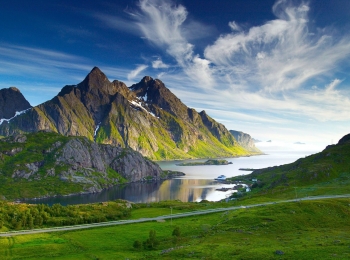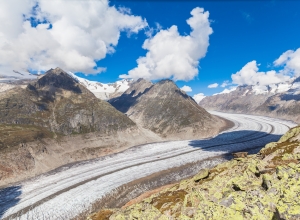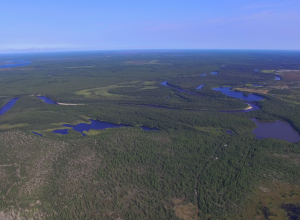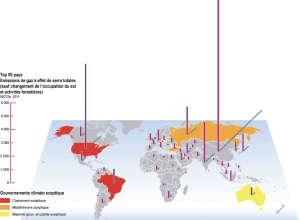A fragile future : can mountain communities adapt to climate change ?
"Climate change threatens the vast high latitude and high-altitude cold regions of the world that provide freshwater to over half of humanity. What impacts of climate change on the cryosphere have already been experienced in Latin America, Central Asia and the Andes? What risks will these regions be exposed to?" It is along these lines that the conference on adaptation of mountain communities to climate change started on November 8, 2021 as part of the adaptation day of the last United Nations Climate Conference – UNFCCC COP26 held in Glasgow (UK). This hybrid event took place at the same time in Geneva and Glasgow and was co-moderated by Dr. Carolina Adler, executive director of the Mountain Research Initiative (MRI) and Dr. Elena Manaenkova, Deputy Secretary-General of the World Meteorological Organization (WMO) since 2016.
What future for our cryosphere?
"Glaciers and the cryosphere are rapidly declining. In parallel, disasters, damages and impacts attributed to anthropogenic climate change are increasing, together with the population dependent on mountain water resources. Ecosystems are heavily affected too." This has been the alarming picture provided by Prof. Christian Huggel (University of Zurich) at the beginning of the conference. Depending on the emission scenarios, the future of glaciers in Asia’s High Mountains will be dramatic: projections of glacier mass change forecasts a loss of at best 29% (RCP 2.6) of their total mass, relative to 2015, and at worst 67% (RCP 8.5). The major issues with this glacier mass change are the cascading impacts it will have, both regarding bio-physical and socio-economical dimensions. In the short term, we can expect an increase in landslides, debris flows, glacier lake outburst floods (GLOF), loss of lives, natural resources, livelihoods and income. In the long-term, a reduction of seasonal meltwater may be expected together with ecosystems degradation, landscape changes and losses, water scarcity, dangers for food security, loss of social order, and eventually identity. To respond to these challenges and to avoid overshoot pathways and irreversible losses, Prof. Huggel underlined the need to improve dialogue between policy negotiators and scientists, especially when it comes to bringing science on the political agenda.
Randy Munoz from the University of Zurich provided a similar alarming picture regarding melting glaciers in the Andes: by the end of the 21st century, almost all glaciers in Latin America will disappear if action for effective and immediate mitigation of climate change impacts is not undertaken. He underlines the fact that it is crucial to take more complex social ecological systems into account: most of the vulnerable people, with lower incomes live on the shores of rivers and are threatened and exposed to extremes events like landslides, floods, GLOFs whose intensity will increase, as a consequence of climate change. He also addressed two other important and relevant risks: food security and water scarcity by providing the striking example of the impact of glacier retreat on agricultural production, domestic water uses and hydropower production. This will account for a loss of 250 to 300 million dollars per year and only for one single catchment in the region. Finally, he points out to the importance to gain a better understanding about the impacts on health and some intangible dimensions like culture, identity, and welfare.
Prof. Martin Hölzle from the University of Fribourg described one of the most important global hotspot in terms of climate change on cryosphere and water resources: Central Asia. For Prof. Hölzle, there is an urge to increase monitoring activities of cryosphere related variables to collect the needed data, allowing sound modelling of future water resources in this region of the world. To do so, some challenges need to be addressed including the improvement of the research capacities, cooperation and empowerment of local researchers, especially young female researchers, the guarantee of access to field sites and the long-term financial support for sustainable scientific activities.
Prof. Markus Stoffel’s (University of Geneva) presentation focused on High Mountain Asia, and especially on what is labelled the "third pole": namely the Himalayas and Tibetan plateau, providing water to more than 1.9 billion people in Asia, almost 25% of the world’s population. This region is the largest freshwater reservoir beside the poles: its surface is over 60'000 km², it is the source of 10 major river systems, supplying water for hydropower, drinking water, agriculture and many other activities. Glaciers in this region, like elsewhere, are ambassadors of climate change: dramatic melting is happening. The number of new glacier lakes will go from 26'000 lakes to 40'000 lakes in 2050, which represents a combined maximum area of 1'510 km² and a combined maximum volume of 50 km3. This increases the risks of extreme glacial lake outbursts and thus, the exposure and vulnerability for people leaving downstream. Prof. Stoffel also highlighted the importance of accurate monitoring systems to provide reliable information to vulnerable communities.
The next speaker, Dr. Carolina Adler, Executive Director of the Mountain Research Initiative, focused on a review of adaptation to climate change in the cryosphere and mountain areas, starting from the 2021 United Nations Environment Program report on the "Adaptation Gap". She maintained that "progress has been made by countries in developing adaptation planning. Gaps are in the implementation and in what we track as effective adaptation". She added that reported adaptation in mountain areas is incremental, fragmented, largely autonomous, responds to negative impacts and risks (rather than leveraging or creating new opportunities). This often leaves local communities to self-organise while adaptation remains under-resourced.
In the face of all these aspects, for adaptation to be successful two important points should be considered. The first one consists in limiting imperatively global warming to 1.5°C and the second is paying attention to who, how and using what narratives and standards the implementation, tracking and reporting on adaptation progress is made.
From the Himalayas and the Andes to Glasgow
The second part of the conference was streamed live from Glasgow and presented by a panel of policy makers among which UNFCCC focal points, the Head of Global Programme on Climate Change and Environment at the Swiss Development Cooperation (SDC), the Deputy Director General of the International Centre for Integrated Mountain Development (ICIMOD), and representatives of NGOs and civil society.
As Ms. Radha Wagle, Nepalese UNFCCC Focal Point Joint Secretary, Ministry of Forest & Environment (MoF) in Nepal and Izabella Koziell, Deputy Director General of ICIMOD pointed out, the Himalayan region is characterised by a fragile ecosystem upon which downstream countries comprising not least than 1.9 billion people greatly depend. For example, the Nepalese policy landscape includes a dedicated ministry, multiple provincial coordination committees and about 20'000 user groups for the implementation of climate adaptation policies. Izabella Koziell emphasised ICIMOD work with communities to co-produce local solutions, such as community-based early warning systems, green enterprises, or disaster risk reduction plans. Knowledge sharing across regions is also a key measure to ensure a solid adaptation policy. Nevertheless, effective science-policy dialogue and an enabling policy and finance environment are necessary to scale up solutions.
The Andes case brought up by M. Miguel Vera-Lugo, biologist and member of the Consorcio para el Desarrollo Sostenible de la Ecorregión Andina (CONDESAN) showed the importance of sociocultural dynamics and the need to exchange data and knowledge across communities as adaptation requires a change of mind-set. Meaning rebuilding the link between human and nature. At stake, the mitigation of the effects on the agricultural system that could lead to a food shortage crisis, as the Andes’ glaciers are showing the highest rate of retreat worldwide. Thus Mr. Vera-Lugo insisted on the importance to work with political leaders and institutions as well with the expectation to include the Andes within the COP agenda.
The contributions of Janine Kuriger, Head of the Global Programme Climate Change & Environment at the Swiss Agency for Development & Cooperation (SDC) and Marlene Kronenberg, glaciologist at the University of Fribourg and founder of "Adventure of science: women and glaciers in Central Asia" concluded the conference. Janine Kuriger highlighted how SDC contributes to improve resilience at local, regional, national and international level. "Addressing the science-policy-practice dimensions is key for successful adaptation at local level" maintained Janine Kuriger. Sound scientific evidence on the impacts of climate change is the backbone for an informed dialogue with policy-makers and for successful implementation of adaptation measures. Traditional knowledge integration is also a central aspect. Several experiences have been presented, including a capacity building program on Himalayan glaciology in partnership with Switzerland, alongside cooperation to strengthen early warning systems capacities, co-development of guidelines for risk management of glacial lake outburst floods and a common framework for climate vulnerability assessments for an informed subnational and national disaster planning. Activities at the global level include a chapter focused on mountains in the IPCC Sixth Assessment Report or a climate adaptation solutions in mountain regions portal in the framework of the Adaptation at Altitude Programme. The conference ended with reflections about the limits to adaptation and the need for a joint mitigation-adaptation action programme for a climate-proof future.
The event recording is available at the following link:
www.gecryohub.ch/session/a-fragile-future-can-mountain-communities-adapt-to-climate-change
Léonard Dharan
Léonard Dharan a suivi le Master en sciences de l'environnement de l'Université de Genève après avoir obtenu son Bachelor en sciences politiques. Intéressé par les dimensions politiques et sociales de l'environnement, il est conscient que l'aménagement des territoires et la gestion commune des ressources représentent un défi actuel majeur. Dans ce cadre, il s'est spécialisé dans l'urbanisme et les enjeux du développement durable.
Océane Garandel
Océane Garandel is a student pursuing a Master in environmental sciences (MUSE) at the University of Geneva. She previously graduated from a Bachelor in European political sciences in Lille. She is particularly interested in matters related to environmental justice and international governance which allows her to combine the two area of studies she had the chance to focus on in her academic background.





